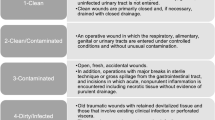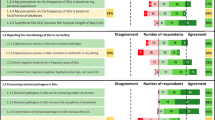Abstract
Purpose
To evaluate whether simultaneous abdominal surgery or wound contamination at the time of ventriculoperitoneal (VP) shunt placement are associated with increased shunt complications.
Methods
Pediatric patients who underwent VP shunt placement were identified using the National Surgical Quality Improvement Program Pediatric database. VP shunt complication rates were compared between patients who underwent simultaneous abdominal surgeries at the time of VP shunt placement vs those who did not and between those with clean/clean-contaminated and contaminated/dirty wound classifications. Adjusted analysis was performed using 1:5 case–control matching.
Results
Among 2715 patients who underwent VP shunt placement, 21 had simultaneous abdominal procedures and were matched with 105 control patients. No significant difference was found in overall (34.3 vs 14.3%, p = 0.07), infectious (8.6 vs 4.8%, p = 1.000), or non-infectious (25.7 vs 9.5%, p = 0.156) shunt complications in the simultaneous vs non-simultaneous group, respectively. In a separate analysis of wound classification, 12 patients with contaminated/dirty wounds were matched with 60 patients with clean/clean-contaminated wounds. The rates of shunt infections for clean/clean-contaminated and contaminated/dirty cases were 10.0 and 16.7%, respectively (p = 0.613).
Conclusion
In our matched case–control study, neither simultaneous abdominal surgery nor wound contamination at the time of VP shunt placement demonstrated significant increased risk of 30-day post-operative complication.


Similar content being viewed by others
References
Vinchon M, Dhellemmes P (2006) Cerebrospinal fluid shunt infection: risk factors and long-term follow-up. Childs Nerv Syst 22(7):692–697
Duhaime AC (2006) Evaluation and management of shunt infections in children with hydrocephalus. Clin Pediatr (Phila) 45(8):705–713
Gutierrez-Murgas Y, Snowden JN (2014) Ventricular shunt infections: immunopathogenesis and clinical management. J Neuroimmunol 276(1–2):1–8
Rogers EA, Kimia A, Madsen JR, Nigrovic LE, Neuman MI (2012) Predictors of ventricular shunt infection among children presenting to a pediatric emergency department. Pediatr Emerg Care 28(5):405–409
Simon TD, Whitlock KB, Riva-Cambrin J, Kestle JR, Rosenfeld M, Dean JM et al (2012) Revision surgeries are associated with significant increased risk of subsequent cerebrospinal fluid shunt infection. Pediatr Infect Dis J 31(6):551–556
Spader HS, Hertzler DA, Kestle JR, Riva-Cambrin J (2015) Risk factors for infection and the effect of an institutional shunt protocol on the incidence of ventricular access device infections in preterm infants. J Neurosurg Pediatr 15(2):156–160
Wu Y, Green NL, Wrensch MR, Zhao S, Gupta N (2007) Ventriculoperitoneal shunt complications in California: 1990 to 2000. Neurosurgery 61(3):557–562 (discussion 562–563)
Habibi Z, Ertiaei A, Nikdad MS, Mirmohseni AS, Afarideh M, Heidari V et al (2016) Predicting ventriculoperitoneal shunt infection in children with hydrocephalus using artificial neural network. Childs Nerv Syst 32(11):2143–2151
Li G, Dutta S (2008) Perioperative management of ventriculoperitoneal shunts during abdominal surgery. Surg Neurol 70(5):492–495 (discussion 495–497)
Mortellaro VE, Chen MK, Pincus D, Kays DW, Islam S, Beierle EA (2009) Infectious risk to ventriculo-peritoneal shunts from gastrointestinal surgery in the pediatric population. J Pediatr Surg 44(6):1201–1204 (discussion 1204–1205)
Devaney L, Rowell KS (2004) Improving surgical wound classification—why it matters. AORN J 80(2):208–209 (212–23)
Klimo P Jr, Van Poppel M, Thompson CJ, Baird LC, Duhaime AC, Flannery AM, Pediatric Hydrocephalus Systematic Review and Evidence-Based Guidelines Task Force (2014) Pediatric hydrocephalus: systematic literature review and evidence-based guidelines. Part 6: Preoperative antibiotics for shunt surgery in children with hydrocephalus: a systematic review and meta-analysis. J Neurosurg Pediatr 14(Suppl 1):44–52
Roeder BE, Said A, Reichelderfer M, Gopal DV (2007) Placement of gastrostomy tubes in patients with ventriculoperitoneal shunts does not result in increased incidence of shunt infection or decreased survival. Dig Dis Sci 52(2):518–522
Bui CJ, Tubbs RS, Pate G, Morgan T, Barnhart DC, Acakpo-Satchivi L et al (2007) Infections of pediatric cerebrospinal fluid shunts related to fundoplication and gastrostomy. J Neurosurg 107(5 Suppl):365–367
American College of Surgeons National Surgical Quality Improvement Program Pediatric. About ACS NSQIP Pediatric. https://www.facs.org/quality-programs/childrens-surgery/pediatric/overview. Accessed 17 Mar 2012
Gonzalez KW, Dalton BG, Kurtz B, Keirsey MC, Oyetunji TA, St Peter SD (2016) Operative wound classification: an inaccurate measure of pediatric surgical morbidity. J Pediatr Surg 51(11):1900–1903
Author information
Authors and Affiliations
Corresponding author
Ethics declarations
Conflict of interest
The authors report no conflict of interest concerning the materials or methods used in this study or the findings specified in this paper.
Rights and permissions
About this article
Cite this article
Miyata, S., Golden, J., Lebedevskiy, O. et al. The role of simultaneous abdominal surgery and wound classification in ventriculoperitoneal shunt complication. Pediatr Surg Int 33, 1221–1230 (2017). https://doi.org/10.1007/s00383-017-4167-3
Accepted:
Published:
Issue Date:
DOI: https://doi.org/10.1007/s00383-017-4167-3




